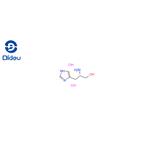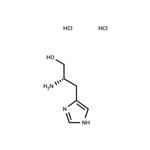Description
L-Histidinol is a natural amino alcohol that serves as an intermediate in the biosynthesis of the amino acid L-histidine in bacteria, archaebacteria, fungi, and plants. It is generated from its immediate precursor, L-histidinol phosphate, by a phosphatase. L-Histidinol is oxidized to L-histidinal, which in turn is oxidized to L-histidine, by a single enzyme, histidinol dehydrogenase.
Chemical Properties
white to slightly beige crystalline powder
Uses
A metabolite within Histidine metabolism.
Definition
ChEBI: L-Histidinol dihydrochloride is an aralkylamine.
in vitro
preliminary experiments were done to investigate the cytotoxic effect of l-histidinol on cultured eac cells. results showed that l-histidinol up to 4 mm had no cytotoxic effects on eac cells. doxorubicin alone showed concentration-dependent cytotoxic effects. l-histidinol combination with doxorubicin led to significant potentiation of doxorubicin cytotoxicity to eac cells compared to doxorubicin alone. the concentration that caused 50% growth inhibition in eac cells after 24 h incubation was about 0.2 μg/ml, whereas it was 0.1 μg/ml when l-histidinol was added to culture medium [1].
in vivo
l-histidinol at 250 mg/kg for five consecutive doses before doxorubicin single injection could enhance the antitumour activity of doxorubicin in eac-bearing mice as demonstrated by a significant increase in average life span and cure rate of mice. in normal mice, l-histidinol, in the same dose regimen, could not alter the acute cardiotoxicity and lethality of doxorubicin [1].
References
[1] al-shabanah oa, badary oa, al-gharably nm, al-sawaf ha. effects of l-histidinol on the antitumour activity and acute cardiotoxicity of doxorubicin in mice. pharmacol res. 1998 sep;38(3):225-30.




